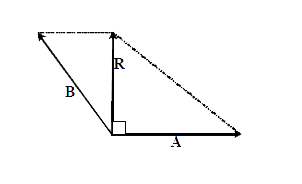Two vector A and B have equal magnitudes. Then the vector A+B is perpendicular to
A×B
A−B
3A−3B
all of these
The correct Answer is:A
To solve the problem, we need to determine which of the given vectors is perpendicular to the vector A+B when the vectors A and B have equal magnitudes.
1. Understanding Perpendicular Vectors:
Two vectors are perpendicular if their dot product is zero. Therefore, we need to check the dot product of A+B with each of the given vectors.
2. Checking the first option: A+B⋅(A×B):
- We calculate the dot product:
(A+B)⋅(A×B)=A⋅(A×B)+B⋅(A×B)
- The dot product of any vector with a vector that is perpendicular to it (like A×B) is zero:
A⋅(A×B)=0andB⋅(A×B)=0
- Therefore, the total is:
0+0=0
- Thus, A+B is perpendicular to A×B.
3. Checking the second option: A+B⋅(A−B):
- We calculate the dot product:
(A+B)⋅(A−B)=A⋅A−A⋅B+B⋅A−B⋅B
- Since A⋅B=B⋅A, we can simplify:
=∥A∥2−∥B∥2
- Given that ∥A∥=∥B∥, we have:
=∥A∥2−∥A∥2=0
- Thus, A−B is also perpendicular to A+B.
4. Checking the third option: A+B⋅(3A−3B):
- Factor out the 3:
(A+B)⋅(3(A−B))=3(A+B)⋅(A−B)
- Since we already established that (A+B)⋅(A−B)=0:
3⋅0=0
- Therefore, 3(A−B) is also perpendicular to A+B.
5. Conclusion:
All three options A×B, A−B, and 3(A−B) are perpendicular to A+B.
Final Answer:
All of the given vectors are perpendicular to A+B.
Two vectors are perpendicular if their dot product is zero. Therefore, we need to check the dot product of A+B with each of the given vectors.
- We calculate the dot product:
(A+B)⋅(A×B)=A⋅(A×B)+B⋅(A×B)
- The dot product of any vector with a vector that is perpendicular to it (like A×B) is zero:
A⋅(A×B)=0andB⋅(A×B)=0
- Therefore, the total is:
0+0=0
- Thus, A+B is perpendicular to A×B.
- We calculate the dot product:
(A+B)⋅(A−B)=A⋅A−A⋅B+B⋅A−B⋅B
- Since A⋅B=B⋅A, we can simplify:
=∥A∥2−∥B∥2
- Given that ∥A∥=∥B∥, we have:
=∥A∥2−∥A∥2=0
- Thus, A−B is also perpendicular to A+B.
- Factor out the 3:
(A+B)⋅(3(A−B))=3(A+B)⋅(A−B)
- Since we already established that (A+B)⋅(A−B)=0:
3⋅0=0
- Therefore, 3(A−B) is also perpendicular to A+B.
All three options A×B, A−B, and 3(A−B) are perpendicular to A+B.
All of the given vectors are perpendicular to A+B.
Similar Questions
Two vectors →Aand→B have equal magnitudes.If magnitude of (→A+→B) is equal to n times of the magnitude of (→A−→B) then the angle between →Aand→B is :-
View SolutionTwo vectors →A and →B lie in X-Y plane. The vector →B is perpendicular to vector →A. If →A=ˆi+ˆj, then →B may be :
View SolutionTwo vectors a and b have equal magnitudes of 12 units. These vectors are making angles 30°and 120° with the x axis respectively. Their sum is r . Find the x and y components of r .
View SolutionTwo vectors →A and →B have equal magnitudes . If magnitude of →A+→B is equal to n× the magnitude of →A−→B , then the angle between →A and →B is
View SolutionThe algebraic sum of two co - initial vectors is 16 units. Their vector sum is 8 units and the resultant of the vectors are perpendicular to the smaller vector. Then magnitudes of the two vectors are -
View SolutionResultant of two vectors one having magnitude twice of other is perpendicular to the smaller vector then find the angle ( in∘) between the vectors ?
View SolutionThere are two vectors →A=3ˆi+ˆj and →B=ˆj+2ˆk. For these two vectors-
(a) Find the component of →A along →B in vector form.
(b) If →A&→B are the adjacent sides of a parallalogram then find the magnitude of its area.
(c) Find a unit vector which is perpendicular to both →A&→B.
View Solution→a and →b are two given vectors. On these vectors as adjacent sides a parallelogram is constructed. The vector which is the altitude of the parallelogam and which is perpendicular to →a is not equal to
View SolutionThe resultant of two vectors A and B is perpendicular to the vector A and its magnitude is equal to half the magnitude of vector B. The angle between A and B is -

View SolutionIf A and B are Two non -zero vector having equal magnitude , the angle between the vector A and A-B is
View Solution
